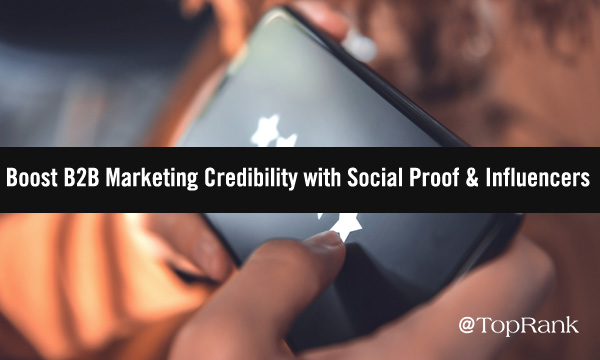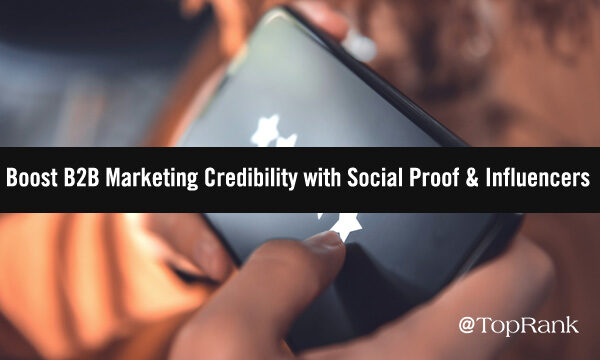
This is gonna be the greatest blog post EVER.
Did you believe me there? You probably didn’t.
Sure, I might think it’s an awesome piece of content. But I’m not exactly an objective source. Now, if you were to come across a post on social media from someone you know and trust, linking to this blog post and saying it’s the best thing they’ve read all year? That’s a different story.
Therein lies the immense value of social proof, which is only growing more impactful as businesses and society evolve into a new era. A survey from Kantar Media last year found that 93% of people trust brand recommendations from family and friends, while only 38% trust information from advertisers. Meanwhile, 84% of people say they trust online reviews as much as their friends.
As a marketer, accepting this reality may cause some discomfort: We can’t control what people say! That’s why a great product and customer experience are table stakes. But when those pieces are in place, today’s marketers can take plenty of steps to strategically encourage and elevate social proof and influencer content.
Building Credibility for Your Brand the Right Way: 4 Key Steps
Going above and beyond with transparency, highlighting third-party voices, portraying influencer authenticity, and creating buzzworthy experiences are among the best ways to build credibility in our current business landscape. A closer look at each:
#1: Embrace Radical Transparency
In business, the term “radical transparency” is usually evoked as an internal management philosophy — keeping employees looped into everything that’s going on, good or bad, to increase engagement and investment. I feel the concept can also be applied externally.
Heightened business transparency is largely happening on its own, in a digital environment where customers and communities can keep a closer eye on a company’s activities and positions.
Why not lean into this transparency? When you proactively put everything out there for people to see, it fuels a perception that you’re not trying to hide anything. That’s a huge credibility booster.
A few examples of transparency that might be considered “radical” but should really start to become the norm:
- Openly acknowledge and address negative reviews instead of burying them
- Share product/service pricing upfront instead of obscuring these important details
- Own the mistakes you make as a company, and share what you learn from them
- Recognize the relative strengths of your competitors in marketing materials, rather than playing up only their weaknesses
- Be forthright about who your product or service is NOT a fit for
If there’s one thing business buyers don’t like, it’s surprises. Given the stakes, nobody wants to find out down the line that there’s an unexpected cost, or unmentioned implementation complexities, or unspoken functional limitations.
Radical transparency helps eliminate surprises and can dramatically increase buyer confidence.
#2: Put Third-Party Reviews and Analysis Forward
As noted earlier, customers tend to be more interested in hearing what other people say about your solutions than what you say about them. That’s not to say a company can’t toot its own horn, but this should be balanced by objective third-party voices.
Think about ways you can incorporate these trusted, unbiased perspectives into your own content. Highlight research from authoritative market analysis firms (e.g. studies from Gartner, Forrester, Nielsen) that helps establish a need for what you offer. Let trends and statistics do the talking. Build out authentic case studies that are more focused on illustrating your solution’s impact in a customer’s organization rather than just heaping lavish praise.
And of course: Point prospective customers to user review sites so they can see for themselves how people describe experiences with your brand. A recent article at Forbes shares tips on getting more reviews and leveraging them effectively.
“Customers tend to be more interested in hearing what other people say about your solutions than what you say about them.” — Nick Nelson @NickNelsonMN Share on X#3: Aim for Authenticity in Influencer Partnerships
Influencer associations can be excellent sources of credibility for your brand … provided they are handled the right way. From our view at TopRank Marketing, that means taking a relationship-based approach more so than a transactional one.
Influencers who are recognized, respected, and trusted in a particular industry or niche can be tremendously valuable advocates. But when your association with them is superficial, that value is lost. Customers will see through it. Nobody’s putting a lot of stock into the genuine sentiments behind a glowing social media post that has an #ad hashtag at the end.
However, when you’re building long-term relationships with these influencers, to the point where they speak positively about your brand unprompted? When their audiences see them engaging with your people and co-creating impactful content? This is where the true credibility-boosting power of B2B influencer marketing lies.
Helping forge these kinds of authentic influencer ecosystems is an area where our agency specializes, so feel free to give us a shout if you want to learn more.
“Influencers who are recognized, respected, and trusted in a particular industry or niche can be tremendously valuable advocates.” — Nick Nelson @NickNelsonMN Share on X#4: Give People Something to Talk About
Increasingly, this is the primary task of the new-age digital marketer: It’s not so much about coming up with different ways to say great things about your brand — it’s about coming up with different ways to get other people to say great things about your brand.
How is this done? There are many ways, including:
- Creation of compelling thought leadership that counters conventional wisdom and gets people talking.
- Virtual events that bring together like-minded people around shared passions and interests pertinent to your industry.
- Delivering notable customer experiences or content experiences that generate buzz on their own.
- Providing exceptional employee experiences that compel team members to openly share how much they enjoy the company and culture.
- Running polls, conversation-starters, and hashtags on social media that expand your brand’s relevant reach and connect it to key topics on your target audience’s mind.
Meanwhile, the type of radical transparency cited in Tip #1 can itself be a means to generate positive chatter about your brand and its credibility. In an older but still highly pertinent article for WIRED about the see-through CEO, Clive Thompson summarized why this is really the only way to go:
“Here’s the interesting paradox: The reputation economy creates an incentive to be more open, not less. Since Internet commentary is inescapable, the only way to influence it is to be part of it. Being transparent, opening up, posting interesting material frequently and often is the only way to amass positive links to yourself and thus to directly influence your Googleable reputation. Putting out more evasion or PR puffery won’t work, because people will either ignore it and not link to it – or worse, pick the spin apart and enshrine those criticisms high on your Google list of life.”
Be part of the commentary. Take the lead in key conversations. Engage with leaders in your space. Act in a way that inspires other people to speak highly of your brand.
Credibility isn’t given; it’s earned. That’s a directive to which everyone across an organization must contribute. But marketers play a key role in earning and showcasing credibility for the brand, and I’d argue that it’s increasingly becoming our most critical job duty. Social proof and influencer marketing are vital cornerstones to doing it well.
Looking for specific guidance on advancing brand credibility through your marketing strategy? Check out my post from last year featuring six tips for infusing credibility into B2B content.



